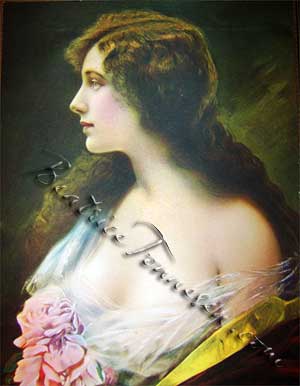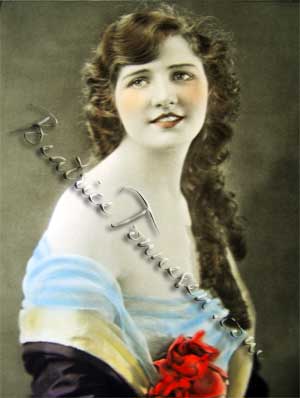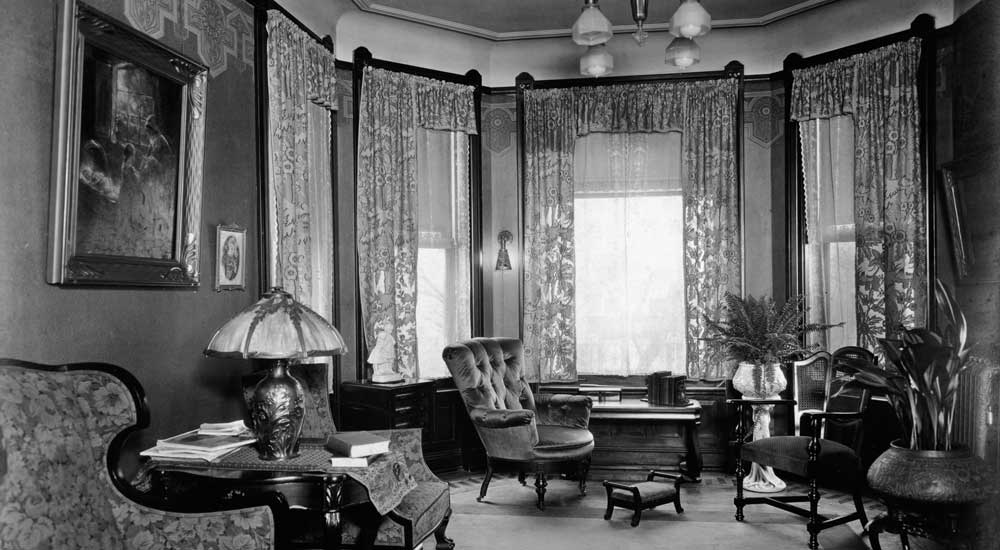In previous articles and Slideshow Albums 1 and 2 (“Introduction” and “Artwork Bearing Signatures and Attributions…”), I reported that many art prints produced between 1900 and the 1930’s began as photos created in the Chicago studio of Beatrice Tonnesen.
Relatively few of these prints were signed by Tonnesen, but many unsigned examples of her work can be identified because:
 1. The images contain props and/or costumes known to have been used by the Tonnesen Studio. Once an item appears in a signed Tonnesen print, its presence in an unsigned print suggests the same point of origin. For example, the fancy footstool shown in Album 2 in Tonnesen’s signed print titled “Where Peace Abides,” is a frequent indicator of Tonnesen’s work. Tonnesen used her props over and over, favoring certain chairs, rugs and costumes that can usually be differentiated from those of other studios. One caveat: In some cases, artists or illustrators painted new backgrounds that were not in the original photo, retaining only the central figure from the original photograph. So those items added by the illustrators are their own creations rather than the photographer’s props. In most cases, this technique seems to have pertained to outdoor, non-studio settings. See the first two images in Album 1 where both exterior backgrounds were added by artists – the first, apparently, by Tonnesen herself and the second, very possibly, by R. A Fox. An example of a painted indoor setting is image 4 in Album 3, which can also be viewed close-up in the section titled “Zoomify an Image,” posted by Sumner. In the original photo by Tonnesen, the nursery decor was non-existent. Because Tonnesen signed the illustration, I assume it was she who added the background painting.
1. The images contain props and/or costumes known to have been used by the Tonnesen Studio. Once an item appears in a signed Tonnesen print, its presence in an unsigned print suggests the same point of origin. For example, the fancy footstool shown in Album 2 in Tonnesen’s signed print titled “Where Peace Abides,” is a frequent indicator of Tonnesen’s work. Tonnesen used her props over and over, favoring certain chairs, rugs and costumes that can usually be differentiated from those of other studios. One caveat: In some cases, artists or illustrators painted new backgrounds that were not in the original photo, retaining only the central figure from the original photograph. So those items added by the illustrators are their own creations rather than the photographer’s props. In most cases, this technique seems to have pertained to outdoor, non-studio settings. See the first two images in Album 1 where both exterior backgrounds were added by artists – the first, apparently, by Tonnesen herself and the second, very possibly, by R. A Fox. An example of a painted indoor setting is image 4 in Album 3, which can also be viewed close-up in the section titled “Zoomify an Image,” posted by Sumner. In the original photo by Tonnesen, the nursery decor was non-existent. Because Tonnesen signed the illustration, I assume it was she who added the background painting.
2. The original photos exist in the Tonnesen Archive of the Oshkosh Public Museum in Oshkosh, Wisconsin. Not everyone could or would travel to Oshkosh to view the archive, but I have posted a number of the prints that originated from archived photos and will add more as time permits.
 3. The images are in collections of persons connected with Tonnesen, and are identified as products of the Tonnesen Studio.
3. The images are in collections of persons connected with Tonnesen, and are identified as products of the Tonnesen Studio.
4. The images were featured and identified in publications of Tonnesen’s era.
5. Child model Betty Crowe is present in the photo or print. The presence of any Tonnesen model in a print or photo hints that it originated with Tonnesen, but it is not a foolproof indicator. Most Tonnesen models worked, at least occasionally, for other studios. However, Betty Crowe, whose image appears both in the Oshkosh Public Museum collection, and in other privately held Tonnesen photos, has stated that she worked only for one photographer – the woman who “discovered” her as she rode a streetcar with her mother in Chicago around 1913. Betty, born in 1910, appears with Virginia Waller, three years her junior, in the image titled “Waiting for their Munsingwear”, the first image in Slideshow Album #1.
Slideshow Album 4 is part of this article. It contains ten images of Tonnesen’s unsigned works and accompanying text. I have many more unsigned images in my collection and will continue to add them as time allows. If readers have others, we’d love to post them.
All Content Copyright 2007 Lois Emerson


Hello Lois,
I have greatly enjoyed your website. I have been a calendar art collector since the mid seventies. At one time I owned an extensive collection of R.A.Fox oil paintings(which I have since sold).
I have a few questions about Miss Tonnesen maybe you can answer. Have you found evidence of any actual training she had in the use of oils or pastels?
I know Mr. Fox used many different sources for his paintings. I have found post- cards, photographs, and other artists work he used for the basis of his paintings. I guess back then they felt the calendar print was such a disposible item that infringement on other works was not too important.
I have owned several prints signed or attributed to Miss Tonnesen that really appear to be the work of Mr. Fox. I guess my querry really is, was Miss Tonnesen just the photographer or the painter too? Did she collaborate with the other artists by providing the image and did they provide the rest? Or did she actually paint the backgrounds and finishing touches on painted works that bear her name? I admire your tenacity to follow your leads and uncover this wonderful information that intrigues so many of us. I wish you much success in your endeavors and I thank you for sharing your information with the rest of us.
Sincerely,
Margene Petros
Hello Lois,
I have owned several prints signed or attributed to Miss Tonnesen that really appear to be the work of RA Fox. My querry is, was she just the photographer or did she actually paint the backgrounds and finishing touches on painted works that bear her name?
Thank you so much for sharing your information with the rest of us.
Sincerely,
Margene Petros
Hi Margene,
Thank you for your kind words. I’m glad you are enjoying the website. Early newspaper clippings indicate that Miss Tonnesen studied art before studying photography. Also, the grand opening announcement of her studio in Menominee, MI in 1895 stated “Miss Tonnesen is also a cultivated artist and is ready to receive orders for oil and water color paintings.” So I think she photographed, painted and signed a number of her own works, such as the print of the toddler shown in the Zoomify feature posted by Sumner. As to the prints attributed to Tonnesen that look like the work of Fox, I have no answer – only a theory. I think they collaborated on certain works and she signed some of them and he signed others. For example, we know that “The Barefoot Boy” (Album 1, Image 4) came from a photographic image created by Tonnesen, yet it is signed only by Fox. At the same time, we know that the glamorous flapper in Album 1 Image 5, was photographed by Tonnesen, and then a very Fox-like background was added, yet the end product bears only Tonnesen’s signature. So, whereas Woolfenden and Ingerle collaborated as Goddard, I think Tonnesen and Fox also collaborated, but they took turns taking the credit for their collaborations, rather than establishing a separate pseudonym for those collaborations. What do you think?
Lois
My wife’s great great grandfather is the old man in the Tonnesen “Father Time” photo. We have a copy of the photo that has been handed down through the generations.
I have been told that another photo of the same great great grandfather is in a Tonnesen article that appeared in a 2004 issue of “Voyageur”.
We have another high quality photo of the same ancestor that could be an unsigned Tonnesen picture.
I am interested in having a knowledgeable person look at this picture.
Hi Lee,\nThank you for writing! We are very interested in any further information you may have about your wife’s great great grandfather or about the photos themselves. The “Father Time” image appears in our Album 5, Image 20, as you probably know. You don’t describe your unsigned photo, but if you haven’t already checked Image 15 in the same slideshow, you’ll find another image of him there. The photo shown in the 2004 Voyageur article is titled “The Next Move” and it shows him playing cards with a young girl. That photo is part of the Tonnesen Archive of the Oshkosh Public Museum. I have a black and white print of a photo of the same man and child, wearing the same clothing as in “The next Move.” In this one, the girl is combing the man’s hair as he reads a newspaper. It was published in the St. Louis Globe Democrat October 5, 1902, titled “A Labor of Love.” I will email you an image of it. Off the top of my head, these are the only images I know of that contain that same man, though I’m sure there are others. Scott Cross, archivist at the Oshkosh Public Museum, authenticated the recent Tonnesen find at the Wineconne Historical Society. You can contact him about your photo through the link to the museum on this website. \nLois